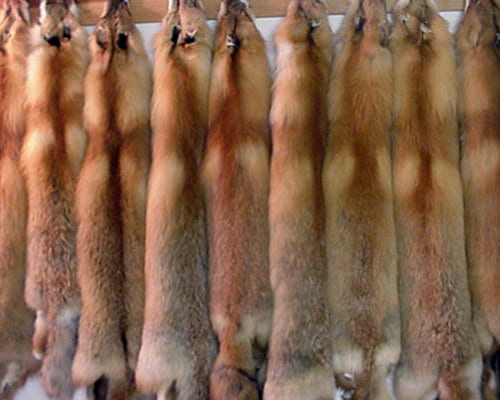Old Job, New World
In Missouri furs used to be traded for trinkets and tools instead of currency. In the pioneer days, early trappers did everything from trapping the animal to selling the pelt. Nowadays trappers sell the fur to traders who then process and sell the pelts (Tew).
Donald Veirs is an 11th generation fur trader in Missouri. His shop in Unionville is unassuming but has a lot of history and still processes many furs. Veirs buys furs from trappers and either processes and sells them or just sells them. Veirs says that the price of furs since he first started in the business has increased substantially. Interestingly, Veirs notes that he would go out of business if it weren’t for the Amish because they are the only people he hires in the busy season (Tew).
Fur trading and trapping of wild animals is fighting an uphill battle against ranches that farm the animals for their fur. 900 out of 1000 mink pelts are farmed. It is also noted that the number of fur traders has decreased dramatically over the years. It is not a stable business and is reliant on market conditions in other parts of the world. To sustain his fur trade business Veirs has to ranch cattle and sell lumber. He only makes money from fur trading every 3 years (Tew).

My First Year Trapper
Missourian Jeff Kitchen fantasized about trapping as a child and at the age of 34 he decided to start. He went to a trappers convention in Columbia, MO. While there he gained as much information as he could about trapping and then he went into his first trapping season (Kitchen).
The first lesson he learned was that trapping is very hard, intense work. There is a lot of trekking with heavy equipment in harsh conditions. Also he got paid very poorly at first (Kitchen).
The second lesson is that trapping is a global enterprise. The price of furs is affected by conditions elsewhere in the world and the furs harvested in Missouri could end up anywhere in the world (Kitchen).
The third lesson is that processing furs is a very valuable and rewarding experience, especially since it is a lost art. This process usually determines how valuable a fur will be. The author describes this process as primitive and connecting to the past (Kitchen).
The fourth lesson learned was that you have to think like an animal to trap them. You have to know all of their habits, where they eat, sleep, and walk. The author became much more aware of the natural environment because he had to observe at the lowest level in order to trap successfully (Kitchen).
The fifth lesson learned was that modern trapping equipment is relatively humane and the animal does not suffer extreme brutality. Also any harm to the animal has the potential to ruin the fur (Kitchen).
The sixth lesson learned is that beavers are not easy to trap. They require more work than most animals because they are bigger, stronger, and live in frozen rivers. The author suggests starting with smaller animals (Kitchen).
The final lesson is that young trappers are the future and will carry on the tradition. He noted that many seasoned trappers were extremely interested in sharing knowledge with young people in hopes of passing down the tradition. He closes by saying that trapping is a unique sport that results in a commercially valuable resource. Also it provides a little income and much enjoyment (Kitchen)!
References
Kitchen, Jeff. “First Year Trapper.” Missouri Conservationist 2 Jan. 2010 : 17-21. Web.
Tew, Christine. “Old Job, New World.” Missouri Conservationist 2 Dec. 2007 : 21-23. Web.
Image from Wikipedia and is freely licensed media